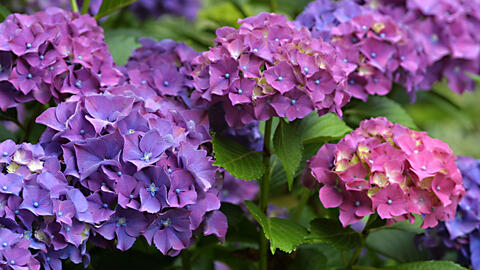The perfect location for your Hydrangeas
If there are problems with the Hydrangeas in your garden, it’s usually due to an unfavorable location. We explain how to find the ideal place for the flowering shrubs.

Hydrangeas only flower luxuriantly in the right location
The natural habitat for most Hydrangea varieties is a partially shaded spot by forest edges or glades. The treetops protect the flowering shrubs from the intense midday sun. The humus-rich soil provides sufficient water even in longer dry periods and at the same time ensures that the humidity in the area surrounding the Hydrangeas is high.
If you want to enjoy free-flowering, healthy Hydrangeas in your garden, you should provide the shrubs with similar conditions. The most challenging species are the popular Hydrangea macrophylla and also the Mountain Hydrangea, as both are also relatively sensitive to frost. As a result, they do not enjoy open, windy locations at all. If there is no suitable protection from eastern winds in the form of larger, denser shrubs, hedges, or walls, the bushes will often suffer severe frost damage in cold winters. However, Panicle Hydrangeas and Smooth Hydrangeas, such as the ‘Annabelle’ variety, are less sensitive. They can be strongly pruned in spring, as they also bloom on new wood.
When you have found your Hydrangeas a wind-sheltered spot in the garden, you should also take a close look at the light situation: hot, dry locations in front of a south facing wall, for example, are very unfavorable – Hydrangea leaves soon begin to droop in direct sunlight. Better: a west facing house wall. The shrubs will not get any direct sunlight until the afternoon, but that is more than enough for Hydrangea macrophylla to form luxuriant flowers. However, a spot under larger shrubs that have an umbrella-like crown and tolerant roots is even better. Scots pines (Pinus sylvestris), for example, which provide the perfect source of shade for rhododendrons, can also act as sunshades for Hydrangeas. Other shrubs that look good with Hydrangeas include flowering dogwood (Cornus kousa and Cornus florida) and larger varieties of Japanese maple (Acer palmatum).

Don’t have anything that will provide shade for your Hydrangea? Just plant something! Put a suitable tree or shrub with a group of several Hydrangeas. It will, however, take a few years before it’s ready to do its job. In all cases, it is important that you enrich the soil with plenty of humus to improve its water holding capacity. You should also mulch it with peat mulch, as this reduces water loss and retains valuable moisture in the soil. This leaves them - the name Hydrangea doesn’t mean ‘water drinker’ for nothing – well prepared to temporarily cope with stronger sunlight.
Nevertheless, they need water, water, and more water if it fails to rain for several days in summer – and ideally tap water with a low lime content or rainwater, because Hydrangeas are naturally quite lime-sensitive.



